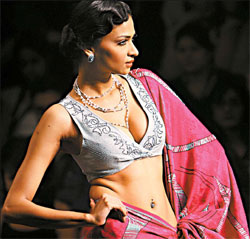Modern designers seduce trendy women into sari fold
A model presents a creation by Indian designer Satya Paul. AFP |
"The sari is such a versatile garment," said Gaurav Gupta, one of 87 designers who will unveil the trends for autumn-winter 2007 at the six-day clothing extravaganza.
"At times people don't wear it because there has not been enough innovation in it," said the designer, who will be putting his "semi-constructed" sari on the catwalk as a new twist to the Indian fashion staple.
Gupta has used ruching and gathering techniques on the garment to make it easier to drape. The sari end, which usually rests on the shoulder, has been constructed like a sleeve to make it easier to handle.
"These experimental saris sell more. Women tell me that I have made them wear the sari again," said the designer.
While some of India's internationally-acclaimed designers such as Manish Arora and Anamika Khanna will focus on Western designs, several others will also be trying to update traditional fashions.
Designers Puneet Nanda and Chiara Nath of the Satya Paul label have gone a step further than Gupta: their sari collection, inspired by the cricket World Cup underway in the Caribbean, has prints of flags of participating countries.
"It is meant for a very bold clientele. We have tried to maintain a balance between saleability and design element," said Nath, whose label has designed saris for popular cricket television show hostess Mandira Bedi.
Various estimates of India's young fashion business put its size between US$50 and 250 million a small fraction of the country's US$12 billion domestic textile industry.
A study released last month by industry body ASSOCHAM estimated that the fashion sector could grow tenfold in the next five years.
Industry watchers also say that despite the growing appeal of Western clothes for daily wear among women, there is little to suggest that there has been a dent in sales of sari.
"It's not that anything has gone out to make space for Western wear, it's just that the wardrobes have got bigger," said Priyadarshini Narendra, Associate Director with retail consultants Technopak Advisors.
Narendra cited the findings of a consumer survey carried out last year, which found that women devoted nearly half of their expenses on clothes to Indian ethnic wear saris and salwar-kameezes, traditional pants and tunic.
"There is so much you can do with a sari the embroideries, the weaves, the prints. The sari lends itself to everything so beautifully. It covers you and yet makes you look sexy," said top fashion consultant Harmeet Bajaj.
Conscious of the limited appeal of the sari with the trendy set, designers said they were trying to keep up with the sensibilities of the stylish woman.
"When I was getting married in 1990, I told myself that this regular sari with a blouse and a petticoat is not for me," said designer Rina Dhaka who is credited with first putting style into the modest sari.
"So I did saris with figure-skimming lycra petticoats and bra tops," said Rina Dhaka.
AFP
(China Daily 03/23/2007 page24)









